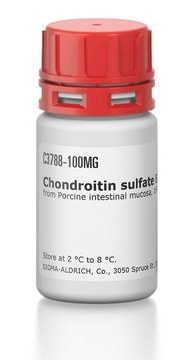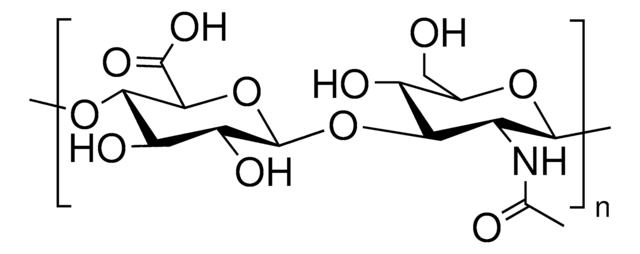C5820
Chondroitin disaccharide Δdi-UA-2S sodium salt
Synonym(s):
α-ΔUA-2S-[1→3]-GalNAc
Sign Into View Organizational & Contract Pricing
All Photos(1)
About This Item
Linear Formula:
C14H19NO14SNa2
CAS Number:
Molecular Weight:
503.34
MDL number:
UNSPSC Code:
12352201
PubChem Substance ID:
Recommended Products
biological source
synthetic
Assay
≥98% (HPLC)
form
powder
technique(s)
HPLC: suitable
storage temp.
−20°C
SMILES string
[Na].CC(=O)NC(C=O)C(OC1OC(=CC(O)C1OS(O)(=O)=O)C(O)=O)C(O)C(O)CO
InChI
1S/C14H21NO14S.Na.H/c1-5(18)15-6(3-16)11(10(21)8(20)4-17)28-14-12(29-30(24,25)26)7(19)2-9(27-14)13(22)23;;/h2-3,6-8,10-12,14,17,19-21H,4H2,1H3,(H,15,18)(H,22,23)(H,24,25,26);;
InChI key
RZWFDDVYBLJQSX-UHFFFAOYSA-N
Application
Chondroitin, a glucosaminoglycan (GAG), is a polysaccharide chain of alternating units of N-acetylgalactosamine (GalNAc) and glucuronic acid (GlcA) that can be sulfated on the either or both GalNAc and GlcA units. Chondroitin and its sulfates are frequently attached to proteins to form proteoglycans.
Packaging
Bottomless glass bottle. Contents are inside inserted fused cone.
Other Notes
ΔUA = 4-deoxy-L-threo-hex-4-enopyranosyluronic acid; GalNAc = N-acetyl-D-galactosamine; 2S = 2-sulfate
Storage Class Code
13 - Non Combustible Solids
WGK
WGK 3
Flash Point(F)
Not applicable
Flash Point(C)
Not applicable
Personal Protective Equipment
dust mask type N95 (US), Eyeshields, Gloves
Choose from one of the most recent versions:
Already Own This Product?
Find documentation for the products that you have recently purchased in the Document Library.
J C F Kwok et al.
The international journal of biochemistry & cell biology, 44(4), 582-586 (2012-01-24)
Chondroitin sulfate is a glycosaminoglycan composed of N-acetylgalactosamine and glucuronic acid. It attaches to a core protein to form chondroitin sulfate proteoglycan (CSPG). Being a major component of the brain extracellular matrix, CSPGs are involved in neural development, axon pathfinding
Yulin Li et al.
Chemical Society reviews, 41(6), 2193-2221 (2011-11-26)
Injectable hydrogels with biodegradability have in situ formability which in vitro/in vivo allows an effective and homogeneous encapsulation of drugs/cells, and convenient in vivo surgical operation in a minimally invasive way, causing smaller scar size and less pain for patients.
Juliane Salbach et al.
Journal of molecular medicine (Berlin, Germany), 90(6), 625-635 (2011-12-22)
To meet the growing need for tissue replacement materials for our aging population, the development of new adaptive biomaterials is essential. The tissues with the highest demand for implant materials are skin and bone. These tissues share various similarities, including
The role of chondroitin sulfate proteoglycans in regeneration and plasticity in the central nervous system.
Galtrey CM, Fawcett JW.
Brain Research. Brain Research Reviews, 54, 1-18 (2007)
Wen-Li Gu et al.
Sheng li ke xue jin zhan [Progress in physiology], 38(2), 101-105 (2007-07-18)
Chondroitin sulfate proteoglycans (CSPGs) are major components of extracellular matrix in the central nervous system (CNS) , and play important roles in the development and maintenance of CNS, as welt in pathogenesis or repair processes of neuronal damages. They mainly
Our team of scientists has experience in all areas of research including Life Science, Material Science, Chemical Synthesis, Chromatography, Analytical and many others.
Contact Technical Service








